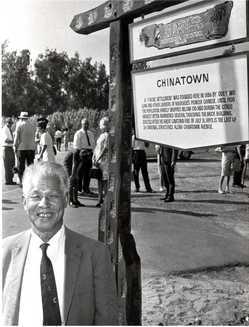The Last Resident of Riverside's Chinatown Still Remembered


To talk about Riverside's Chinatown, one has to mention the last resident who took on the role to be a lone preservationist and oral historian. His name was George Wong.
Born in 1900 as Wong Ho Leun, he immigrated to the U.S. in 1914 at age 14. He lived the rest of his life in Chinatown until shortly before his death in 1974.
For years, he was the only resident. He lived in a small home hidden by his collection of old cars and overgrown brush. For those looking in, it was a junkyard. For Wong, the land was a shrine to the Chinese-Americans who lived in Riverside, like his father, Wong Ben Chow.
Chow was one of the migrates from China who ended up in the Inland Empire. At the turn of the 20th Century, he managed a vegetable farm along the Santa Ana River, according to the Press-Enterprise. Then Chinatown emptied by the 1920s, and by 1943, the land was purchased and divided between Evergreen Cemetery and Wong.
As the lone guardian of the site, Wong became a mysterious presence next to the cemetery, Victorian homes and an early version of a strip mall. He also became city lore, known to be filled with stories of Chinatown's days as a social center for the Inland Empire's Chinese.
Rumors, that later were confirmed as true, was Wong was not afraid to let it be know there was a shotgun on the premises. There was very little trespassing in the former Chinatown.
It almost became a rite of passage to start a conversation with Wong, but as soon as people got to know the college educated bachelor loner, friendships lasted.
"I tried to deal with Mr. Wong a bunch of times. He had about 15, maybe 20, cars above ground," says Riverside resident Gus Barrier. "He had two Woodies that I wanted. I just couldn't get him to sell either one, but he was great to talk to."
Kevin Akin recalls walking past the lot after school and forming a friendship with Wong through the years.
"He would joke about my long hair representing freedom. It was 1965, and here was a kid with a beard and George told me, 'Chinese people had cut off their long hair a long time ago'," recalls Akin, who is married to Dr. Marge Akin, a member of Save Our Chinatown committee. "He taught me that in 1911, with the success of the Republic Revolution, men cut off their queue as a sign of liberation."
The eccentric Wong was rather wise to those who listened.

There wasn't complete civic aloofness to what Wong represented to Riverside. In 1961, a street was named after him as a gesture by a city council member who befriended him.
Yet, it led to the street being named Wong Way, which many considered an adolescent poke in the ribs by the city. Others say Wong was delighted and honored to have the street named after him, in any manner. However, Wong did hand draw his full name in Chinese characters after the sign was installed.
Wong died in the early 1970s, and the last remaining bits of Chinatown went with him. In 1999, Wong Way was replaced with Wong Street--complete with Chinese characters.
The stories linger on. While Mapquest still refers to the street as Wong Way, there are residents who remember a man simply known as George.
Read more about Riverside's Chinatown